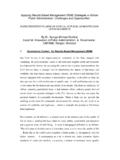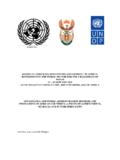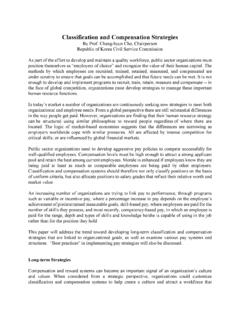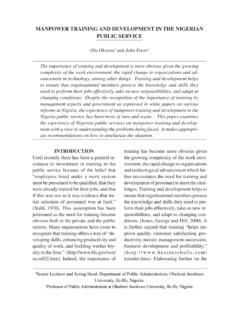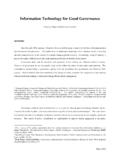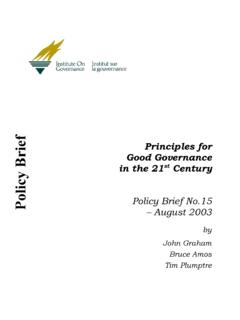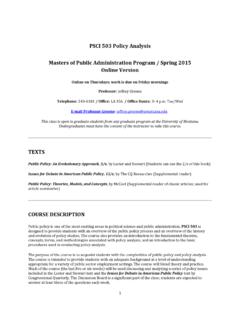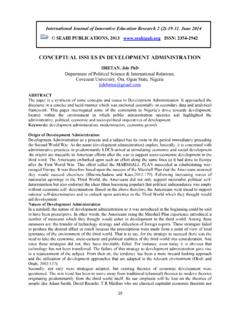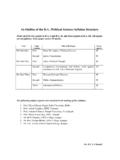Transcription of MODERN MANAGEMET THEORIES AND PRACTICES
1 0 MODERN MANAGEMENT THEORIES AND PRACTICES By Dr. Yasin Olum Lecturer Department of Political Science and public administration Makerere University Contact Address: Makerere University Faculty of Social Sciences Department of Political Science and public administration P. O. Box 7062 KAMPALA-Uganda Tel.(Off.): 041-531499 Tel.(Mobile): 077454019 Fax: 041-534181 E-Mail: Being a paper presented at the 15th East African Central Banking Course, held on 12th July 2004, at Kenya School of Monetary Studies. 1 MODERN MANAGEMENT THEORIES AND PRACTICES : A CRITICAL OVERVIEW Introduction Managing is one of the most important human activities. From the time human beings began forming social organizations to accomplish aims and objectives they could not accomplish as individuals, managing has been essential to ensure the coordination of individual efforts.
2 As society continuously relied on group effort, and as many organized groups have become large, the task of managers has been increasing in importance and complexity. Henceforth, managerial theory has become crucial in the way managers manage complex organizations. The central thesis of this paper is that although some managers in different parts of the world could have achieved managerial success without having basic theoretical knowledge in management, it has to be unequivocally emphasized that those managers who have mixed management theory in their day-to-day practice, have had better chances of managing their organizations more efficiently and effectively to achieve both individual and organizational objectives. Therefore, managers of contemporary organizations ought to appreciate the important role they play in their respective organizations if they are to achieve set goals.
3 Secondly, there is need to promote excellence among all persons in organizations, especially among managers themselves. To address these concerns, the paper will proceed along the following spectrum: management will be defined for purposes of conceptual clarity; management objectives, functions, goals, and essentiality, will be highlighted; the importance of managerial skills and the organizational hierarchy will be sketched; the importance of women in the organizational hierarchy will be emphasized; reasons for studying management theory will be enumerated; the different management THEORIES , the core of the paper, will be discussed at length; the 2significance of management as a practice will be contextualized; and the way forward in form of a conclusion will be offered.
4 Definition of Management Management is the art, or science, of achieving goals through people. Since managers also supervise, management can be interpreted to mean literally looking over , making sure people do what they are supposed to do. Managers are, therefore, expected to ensure greater productivity or, using the current jargon, continuous improvement . More broadly, management is the process of designing and maintaining an environment in which individuals, working together in groups, efficiently accomplish selected aims (Koontz and Weihrich 1990, p. 4). In its expanded form, this basic definition means several things. First, as managers, people carry out the managerial functions of planning, organizing, staffing, leading, and controlling.
5 Second, management applies to any kind of organization. Third, management applies to managers at all organizational levels. Fourth, the aim of all managers is the same to create surplus. Finally, managing is concerned with productivity this implies effectiveness and efficiency. Thus, management refers to the development of bureaucracy that derives its importance from the need for strategic planning, co-ordination, directing and controlling of large and complex decision-making process. Essentially, therefore, management entails the acquisition of managerial competence, and effectiveness in the following key areas: problem solving, administration , human resource management, and organizational leadership. First and foremost, management is about solving problems that keep emerging all the time in the course of an organization struggling to achieve its goals and 3objectives.
6 Problem solving should be accompanied by problem identification, analysis and the implementation of remedies to managerial problems. Second, administration involves following laid down procedures (although procedures or rules should not be seen as ends in themselves) for the execution, control, communication, delegation and crisis management. Third, human resource management should be based on strategic integration of human resource, assessment of workers, and exchange of ideas between shareholders and workers. Finally, organizational leadership should be developed along lines of interpersonal relationship, teamwork, self-motivation to perform, emotional strength and maturity to handle situations, personal integrity, and general management skills.
7 Management Objectives, Functions, Goals, and Essentiality Management Objectives There are basically three management objectives. One objective is ensuring organizational goals and targets are met with least cost and minimum waste. The second objective is looking after health and welfare, and safety of staff. The third objective is protecting the machinery and resources of the organization, including the human resources. Management Functions To understand management, it is imperative that we break it down into five managerial functions, namely; planning, organizing, staffing, leading, and controlling. Planning involves selecting missions and objectives and the actions to achieve them. It requires decision-making , choosing future courses of action from among alternatives.
8 Plans range from overall purposes and objectives to the most detailed actions to be taken. No real plan exists until a decision a commitment 4of human and material resources has been made. In other words, before a decision is made, all that exists is planning study, analysis, or a proposal; there is no real plan. People working together in groups to achieve some goal must have roles to play. Generally, these roles have to be defined and structured by someone who wants to make sure that people contribute in a specific way to group effort. Organizing, therefore, is that part of management that involves establishing an intentional structure of roles for people to fill in an organization. Intentional in that all tasks necessary to accomplish goals are assigned and assigned to people who can do them best.
9 Indeed, the purpose of an organizational structure is to help in creating an environment for human performance. However, designing an organizational structure is not an easy managerial task because many problems are encountered in making structures fit situations, including both defining the kind of jobs that must be done and finding the people to do them. Staffing involves filling, and keeping filled, the positions in the organization structure. This is done by identifying work-force requirements; inventorying the people available; and recruiting, selecting, placing, promoting, appraising, planning the careers of, compensating, and training or otherwise developing both candidates and current jobholders to accomplish their tasks effectively and efficiently.
10 Leading is the influencing of people so that they will contribute to organization and group goals; it has to do predominantly with the interpersonal aspect of managing. Most important problems to managers arise from people their desires and attitudes, their behavior as individuals and in groups. Hence, effective managers need to be effective leaders. Leading involves motivation, leadership styles and approaches and communication. 5 Controlling, for example, budget for expense, is the measuring and correcting of activities of subordinates to ensure that events conform to plans. It measures performance against goals and plans, shows where negative deviations exist, and, by putting in motion actions to correct deviations, helps ensure accomplishment of plans.
